
Ghai Essential Pediatrics8th
.pdf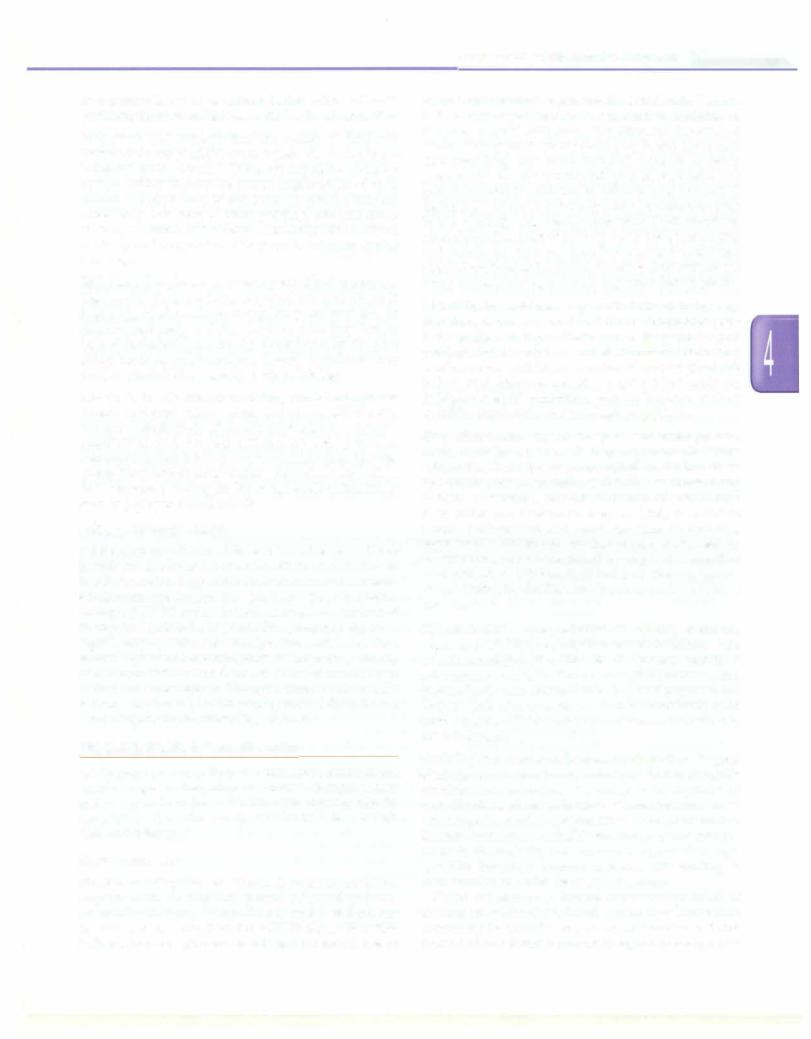
re-organizational or accommodating effort of brain parallelingthemultifoldincreaseinitsfunctional capabilities.
Early phase. The 'concrete thinking model' of childhood persists into early adolescence, where the concepts are perceived more 'literally'. Teens are impulsive and have limited ability to perceive future implications of their current behavior. They prefer same sex peers. Many are excessively conscious of other people's concerns about their appearance and actions. Curiosity about sexual anatomy and comparison with peers is common during this stage.
Mid-phase. This phase is marked by emotional autonomy. The youth starts to think beyond self and there is beginning of abstract reasoning. They are now able to question and analyze. This is the time when they tend to have detachment from family. Acceptance by the peer group becomes very important. Sexual experimentation such as masturbation usually starts at this age.
Late phase. By this time, most of the pubertal changes are already achieved. Moral values and strong self identity are now established. They are now able to suppress impulsivity and are less affected by peer pressure. Personal relations become more important than the peer group. The youthbecomes career oriented and starts short and longterm planning for his or her goals in life. Many start engaging in sexual activity.
Attitude Towards Health
Adolescents are often considered to be at the peak of their health; yet, adolescence coincides with the onset of many health disorders. High-risk behavior is common in mid adolescent age group. The National Family Health Survey 3 (NFHS3)reported the median ageofsexual debut in boys and girls to be 23 yr and 18 yr, respectively, but a significantproportionaresexuallyactive muchbeforethat. Knowledge about contraception is improving among adolescents and most of them are aware of at least some method of contraception. Though awareness about HIV is increasing among Indian youth, most of them do not have comprehensive knowledge about it.
PROBLEMS FACED BY ADOLESCENTS
Adolescents are under immense pressure because of the rapid changes in their hormonal milieu, changing ideas and concepts about the world, having to cope up with the expectations from the society and the need to establish their own identity.
Health Problems
Nutrition or Eatingdisorders. Thereisincreaseinnutritional requirements during this period of rapid growth, micronutrients being as important as energy and protein (see Chapter 6). Data from the NFHS3 shows that 56% Indian adolescent girls are anemic and the prevalence of
Adolescent Health and Development -
anemia remains unchanged over the last decade. There is lack of sun-exposure due to our modest tradition of clothing coupled with dark skin pigment. Insufficient intake of dairy productsresultsin poor intake of calcium. The resulting low bone mineral density is more pronounced in underprivileged girls as they have low protein intake in addition to calcium and vitamin D deficiency. Vitamin Adeficiencyis also animportantissue in economically deprived adolescents. Undernutrition often delays the onset of puberty and sexual maturation, and results in stunting, poor bone mass accrual and reducedworkcapacity. Anorexia nervosa and bulimia are being increasingly reported among urban Indian youth.
Mental health problems. Adjustment disorder, anxiety disorders, depression, suicide, delinquent behavior, poor body image and low self-esteem are the psychological problemsfaced by adolescents. Suicideratesareincreasing in adolescents, with higher number of completed suicide in boys and attempted suicides in girls. Adolescents are at higher risk of committing suicide because of their cognitive immaturity and increased impulsivity.
Sleep disturbances. During the period of rapid growth, adolescents have increased sleep requirements. Many urban adolescents do not get enoughsleep due to various reasons likeincreasingacademicactivity,parentsworking in shifts or watching television late into the night. Poor sleep habits and inadequate sleep are likely to reflect in school performance and cause daytime drowsiness, aggressive behavior, conduct disorders, anxiety, restless leg syndrome and depression. Sleep deprived teens often have periods of subconscious bouts of sleep or 'micro sleeps' during the daytime, making them prone to injuries and accidents.
Infections. With increased outdoor activity, teens are exposed to TB, HIV, sexually transmitted infections, skin infections and parasitic infections. Early sexual activity is not uncommoninIndia. Variousbiological (immatureand incompletely estrogenized mucosa) and psychosocial factors (lack of preparedness, lack of familiarity with barrier contraceptives) make an adolescent susceptible to these infections.
Genital infections and sexually transmitted infections. Vaginal
discharge is common in adolescent girls and may signify physiological leucorrhea of puberty or endogenous or sexually transmitted infections. Gonorrhea can cause vulvovaginitis, urethritisor proctitis. Chlamydiacancause intermenstrual or postcoital bleeds. Both may be asympto matic in the majority and can cause vaginal discharge. Candidal infections become common with starting of menstruation and often have a cyclic nature.
Pelvic inflammatory disease (PIO) is a spectrum of inflammatory disorder of female genital tract. PIO occurs commonly in sexually active young females and can present with abdominal pain with vaginal discharge. The

|
|
s |
------- |
|
|
|
E_ssentia r _Pe_diatric_ --------------- |
- |
|
|
__ |
|
----------- |
|
|
|
|
||
illness is difficult to treat with oral antibiotics and needs hospitalization and intravenous antibiotics (Table 4.1).
Lifestyle diseases. Obesity is the other end on the spectrum of malnutrition and is epidemic in the urban settings. Among Delhi school children, 5% obesity and 17-19% overweight has been reported; similarfiguresare available from other parts of urban India as well. The prevalence of obesity andoverweight ishigherinboysthangirls.Obesity has strong association with asthma, sleep disorders, reflux disease, Blount disease, slipped femoral epiphysis, gallstones, fatty liver and numerous metabolic derange mentslike type2 diabetes, dyslipidemia, hypertensionand polycystic ovary disease. Essential hypertension is rising among Indian youth. There is a close relationship between obesity, hypertension and type 2 diabetes mellitus. Sedentary lifestyle, increasedconsumptionofcalorie dense food and decreased outdoor activity contribute to these disorders.
Problems specific to females. It is common to have anovulatory and irregular menstrual cycles during first two years aftermenarche.Thepolycysticovary syndrome, withacombination of menstrual irregularities andovarian cysts with androgen excess like acne or hirsutism, occurs in around 9% of Indian adolescent girls. The condition has association with other metabolic derangements like obesity, insulin resistance and type 2 diabetes.
Substance abuse. This is an issue in urban as well as rural India. Most of the tobacco and alcohol use starts during adolescence. The Global Youth Tobacco Survey 2009 showed that 14% of school youth reported using tobacco currently. Alcohol (21%), cannabis (3%) and opium (0.4%) are the most prevalent substanceabuse other than tobacco in Indian youth. Addicts are more prone to accidents, injuries,violence,tradingsex-for-drugs, HIV, hepatitisC, sexually transmitted diseases and tuberculosis.
Vulnerability
Abuse and violence (physical and sexual). Physical andsexual violence is common in India, with 20-30% young females suffering fromdomesticviolence and 5-9% young females reporting sexual violence (NFHS3). Accidents are the major cause of mortality in this age group. Road traffic accidents, burns and poisoning are leading causes of trau matic mortality and disability in Indian youth. Motor vehicle and industrial accidents are common in boys whereas burns are commoner in girls.
Migration. Many adolescents migrate from rural to urban settings for labour or educational opportunities. Traffic kingofyouth isaseriousprobleminIndiaandhappensfor industrial or domestic labour, forced marriages and prostitution. Instateslike Bihar,70%ofnewHIVinfections are related to outward male migration.
|
Table 4.1: Sexually transmitted infections: Salient features and treatment |
|
Disease |
Salient features |
Specific treatment |
Gonorrhea |
Coinfection common |
Ceftriaxone 125 mg IV or IM single dose |
Chlamydia |
Urethritis, vaginal |
Oral azithromycin 1 g single dose, or doxycycline 100 mg twice |
|
discharge |
daily for 14 days |
Herpes |
Multiple painful vesicles and |
Oral acyclovir 400 mg thrice daily for 7 days |
|
ulcers; tend to recur |
|
Primary syphilis |
Painless genital ulcer |
Benzathine penicillin 2.4 MU IM (after test dose); oral doxycycline, |
|
|
if allergic to penicillin |
Genital warts |
Tend to recur |
Local application of podophyllin weekly, cryotherapy or surgical |
(papilloma virus) |
|
removal; preventable with vaccination |
Chancroid |
Painful ulcer with |
Oralazithromycin 1 g single dose or ciprofloxacin 500 mg twice daily |
|
lymphadenopathy |
for 3 days |
Trichomoniasis |
Malodorous yellow green |
Oral metronidazole or tinidazole 2 g single dose |
|
discharge |
|
Candidiasis |
Itching, redness, white discharge |
Clotrimazole cream or pessary for 7 days, miconazole pessary |
|
|
for 3 days or oral fluconazole 150 mg single dose |
Pelvic inflammatory |
Polymicrobial; varied disease |
Mild to moderate illness. Oral cefixime 400 mg twice daily |
disease |
spectrum |
for 7 days, metronidazole 400 mg orally twice daily for 14 days |
|
|
and doxycycline 100 mg twice daily for 14 days; abstinence; |
|
|
symptomatic treatment |
|
|
Severe disease or mild to moderate illness nonresponsive to above. IV |
|
|
antibiotics |
Pediculosis pubis |
Pruritus |
Local application of 1% permethrin, wash after 10 min |
Scabies |
Pruritus and rash |
Local application of 5% permethrin or oral ivermectin 2 doses |
|
|
14 days apart |
All patients should be screened for HIV infection; partners should be treated if affected; IM intramuscular; IV intravenous
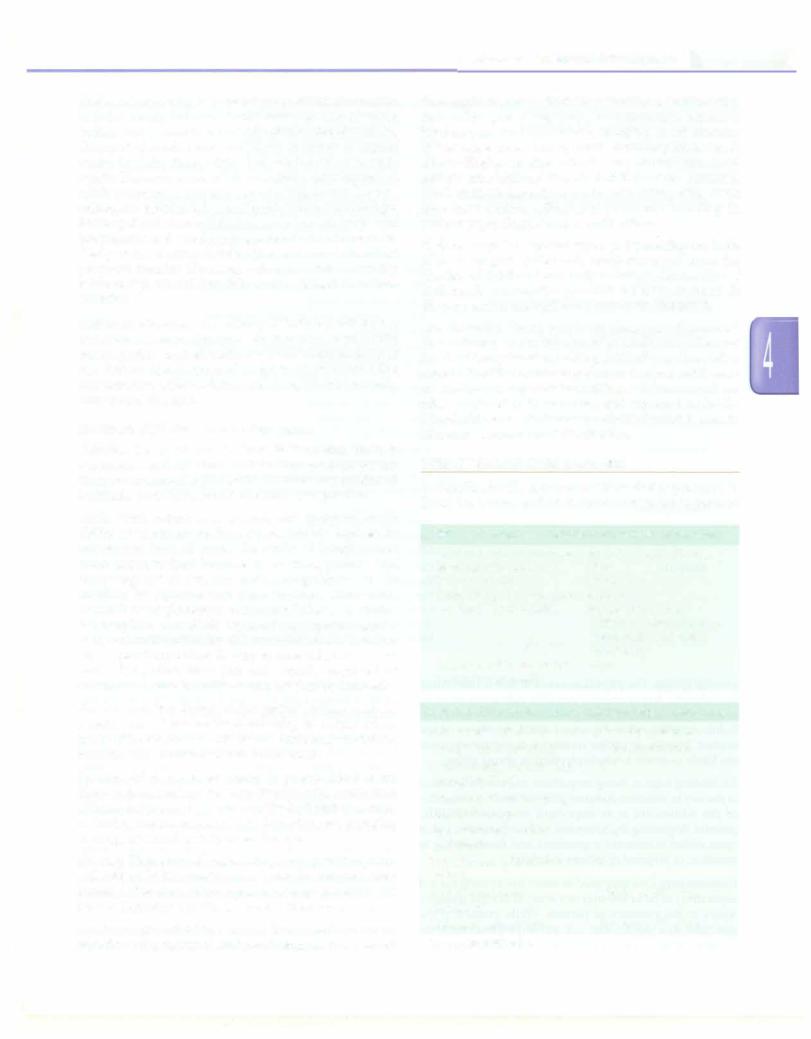
Adolescentpregnancy.Adolescentpregnanciesarecommon in India, mainly because of early marriage. 22% of young Indianwomenhavetheirfirstchildbirthbefore 18yrofage. Unmarried adolescents are likely to resort to unsafe methods of abortions, which increase the risk of compli cationslikesepticemiaandalso mortality.Ascompared to adult pregnancy, they are also at a higher risk for pre eclampsia, preterm labor and postpartum hemorrhage. Prolonged and obstructed labor is common in adolescent pregnancies and young girls are two to four times more likely to die during childbirth as compared to adult pregnant females. Neonatal, infant and child mortality ratesarehigherin childrendeliveredtoadolescentmothers (NFHS3).
Lack ofsex education. The majority of Indian youth do not get formal sex education in an effective way. Peers, books and magazines aretheir main sourcesof informationabout sex. Parents and teachers often fail to discuss issues like masturbation, safe sex, dating, abortion, HIV and sexually transmitted diseases.
Environmental and Social Challenges
Pollution. The incidence of asthma is increasing. There is ongoingresearchintotheroleof electromagnetic exposure from communication devices in disorders like childhood leukemia, brain tumors and immune dysregulation.
Medin. With reduction in poverty and increased avail ability of electronic media, adolescents are exposed to information from all across the world. This exposure is often unsupervised because of working parents and increasing use of personal electronic gadgets. Due to inability to separate fact from fantasy, adolescents succumb tothe glamorous portrayal of tobacco or alcohol consumption, unrealistic expectations, physical aggres sion, destructive behavior and unprotected sex. In urban areas, spending much of their spare time indoors on social networking sites, teenagers are actually deprived of sunlight and physical activity and are socially isolated.
Peer pressure. Peer formation is a part of adolescent social development. Pressure for conforming to norms drives many of their actions and decisions, including risk taking behavior and initiation of substance abuse.
Poverty. Adolescents belonging to poorer families are likely to have inadequate diets. Studies have shown that children belonging to poorer families had higher chances of having depression, antisocial behavior and engaging in drugs or sexual activity at earlier ages.
Illiteracy. Though thesituationisimprovingovertheyears, still 33% of Indian youth are not able to complete their primary education.Female gender belonging to rural and poor background are risk factors for illiteracy.
Academic and emotional stress. Examinations cause significant physiological and psychological stress. Apart
Adolescent Health and Development -
fromrapid changes in theirbody structures, various other factors like peer acceptance, discrimination, academic burden, parental expectations, changing social environ ments cause stress among youth. Switching from verna cular to English mediumschools, long hours of school and tuitions are additional stress factors that are unaddressed. While most adolescents have adequate coping skills, some may have serious adjustment problems resulting in various psychological and somatic effects.
Early marriage. Though the legal age for marriage in India is 18 yr for girls (Table 4.2), many states still have the practice of childhood and early marriage.Almost 30% of Indian girlsbetween the ages of 15 and 19 yr are married; the proportions are higher in rural areas (Table 4.3).
Discrimination. Young people are often treated as second class citizens, under the control of adults and often not involvedinanydecisionmaking.Adolescentgirlsareoften asked tolimittheiroutdoororextracurricularactivitiesand are involved in any decision making.Adolescent girls are often confined to their houses and expected to do the household work. Gender based discrimination is seen in education and even food distribution.
ROLE OF HEALTH CARE PROVIDER
A checklist for the Adolescent Clinic visit is provided in Table 4.4. During each visit, the following are important:
Table 4.2: Legal age definitions relevant to adolescence
Minimum age for marriage Responsibility for crime Juvenile criminal Compulsory free education Consumption of alcohol
Employment in hazardous occupation or hotels
Boys 21 yr; girls 18 yr 12 yr
12-18 yr
6-14 yr
Beyond 18-25 yr in different states (illegal in some states and union territories)
14 yr
Table 4.3: State of the World's Children: Adolescents in India
Adolescents (10-19 yr) |
20% of population |
Young people (10-24 yr) |
33% of population |
Girls currently married (age |
30% |
group 15-19 yr) |
|
Boys currently married (age |
5% |
group 15-19 yr) |
|
Age before 18 yr at first |
22% |
childbirth |
|
Net attendance in secondary |
54% |
school |
|
Youth literacy rates |
88% boys; 74% girls |
(15-24 yr) |
|
Knowledge about HIV |
35% boys; 19% girls |
Source: UNICEF, 2011 |
|
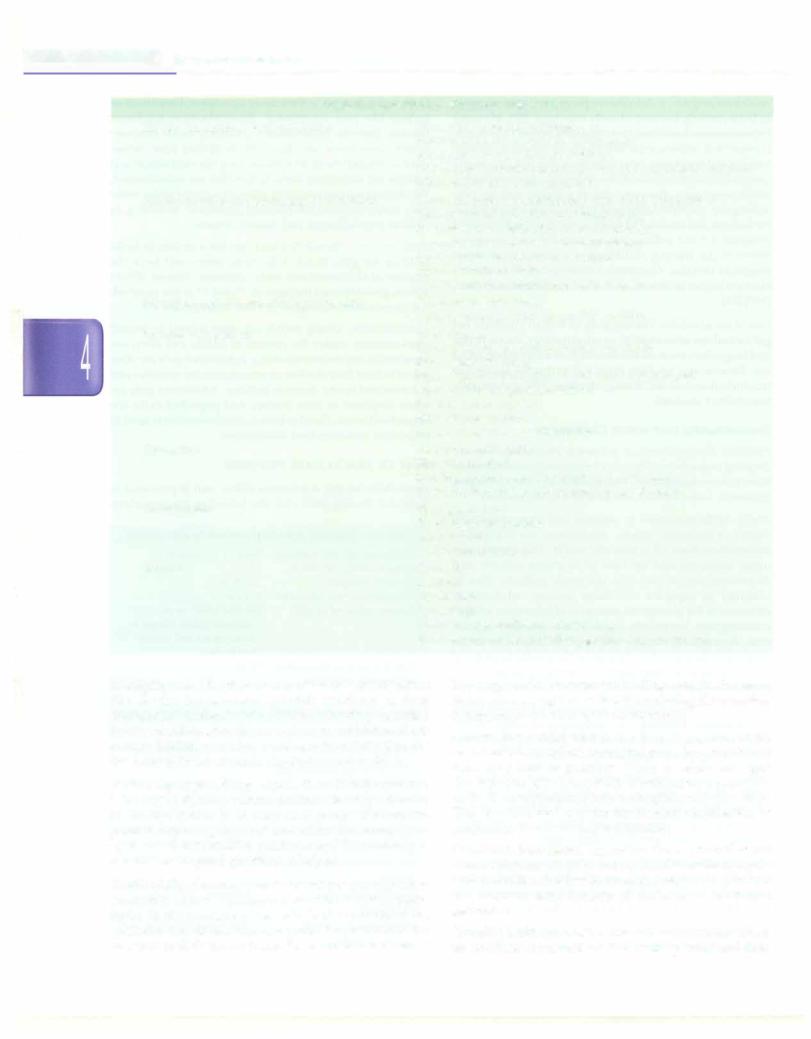
___E s s e n tia P e d iatrics_________________________________
_ _ _ _ _ _ _ _ _ _ _ _ _ _ _
Table 4.4: Checklist for adolescent health visit
History from parents and adolescent |
History of presenting problems |
|
Parental concerns on growth, development |
|
Academic success; school absenteeism |
|
Diet history including calcium, protein and iron intake; junk food |
|
Menstrual history; sleep problems |
History on separate questioning of adolescent |
Emotional problems; relationship with family and peers |
|
Outlook towards physical and sexual changes |
|
Involvement in relationship or sexual activity |
|
Awareness about safe sex and contraception |
|
Specific problems related to sex organs |
|
Tobacco or other substance use |
|
Counsel and clear doubts on sensitive topics |
History on separate questioning of parents |
Relationship with family |
|
Level of communication on sensitive matters |
Physical examination |
Anthropometry |
|
Blood pressure, markers of obesity, acanthosis |
|
Sexual maturity rating |
|
Signs of malnutrition, anemia and vitamin deficiencies |
|
Signs of skin and genital infections |
|
Level of general hygiene |
|
Signs of trauma; abuse |
|
Signs of drug abuse or tobacco use |
Counseling |
Nutritional intervention |
|
Hygienic practices |
|
Building rapport between parents and adolescent |
|
Providing information and sources on sex education |
Investigations |
Hemoglobin level |
|
Blood sugar, lipid profile |
|
Genital swabs |
|
Ultrasound of ovaries |
Referrals |
Counselor |
|
Dietitian |
|
Psychiatrist |
|
Gynecologist |
|
Voluntary and confidential HIV testing |
|
Social services, child protection agencies, support groups |
Identijt;ing risks. The physician needs to detect risk factors like obesity, hypertension, possible substance or drug abuse, behavioraland social problems and risky behavior. Subtle cues like sad or depressed mood, avoidance of eye contact, bruises or undue resistance to examination are the likely pointers towards physical or sexual abuse.
Establishing rapport. Being empathetic and nonjudgmental is the key to effective communication. Direct questioning of the adolescent is as important as questioning the parents. Beginning the interview with icebreakers, use of open ended nonsensitive questions and then moving to sensitive or targeted questions is helpful.
Confidentiality. One may needtointerviewa young patient separately, as he or she may not want to discuss sensitive topics in the presence of parents. While examining the genitalia, the doctor can ask patient's preference for presence of their parent inside the examination room. A
boy may prefer his parents standing outside the exam room, whereas a girl may find it comforting if her mother accompanies her during the examination.
Consent. For a child who is less than 12 yr, consent for examination or medical or surgical procedure is obtained from the parent or guardian. While an adolescent aged 12-18 yr can give consent for examination, consent for medical or surgical procedurecanbe givenonlyafter18 yr. This also includes consent for medical termination of pregnancy, blood and organ donation.
Nutritional intervention. Improving the nutritional status of an adolescent girl helps in two ways. It breaks the cycle of malnutrition and low birthweight babies and prevents the longterm complications of the latter in the future generation.
Providing health information. The adolescent health visit is an excellent opportunity to talk to the parents and their
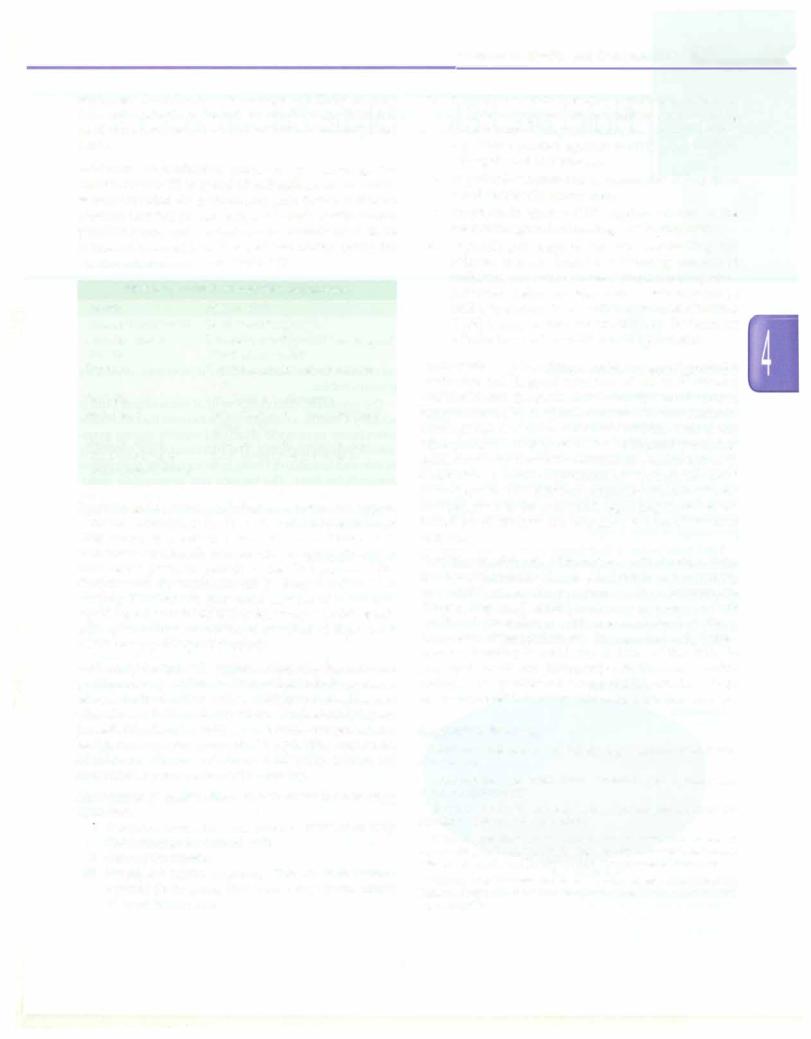
adolescentabout the pubertal changes. It is likely thatthey have not received any formal sex education in school and need to be provided correct educational resources for the same.
Adolescent immunization. India has low coverage for booster doses of TIat 10 and 16 yr. Papillomavirus vaccine is recommended for peripubertal girls (before initiation of sexual activity) for prevention of infection with human papillomavirus and cervical cancer. Parents need to be counseled thoroughly as the principle behind giving the vaccine might alarm them (Table 4.5).
Table 4.5: Immunization during adolescence
Vaccine |
Age; schedule |
Tetanus toxoid or Td |
Booster at 10 and 16 yr |
Measles, mumps, |
One dose; twodoses 4-8weeks apart |
rubella |
if not given earlier |
Typhoid |
Vi polysaccharide vaccine; every |
|
3 yr |
Varicella |
Two doses 8 weeks apart |
Hepatitis B |
Three doses at 0, 1 and 6 mo if not |
|
given earlier |
Papillomavirus |
Three doses at (0, 1 and 6 mo) at |
(adolescent girls, |
11-12 yr (may be given up to |
before sexual debut) |
26 yr) |
Referral tosocialservices, psychological evaluation and support.
National Commission for Protection of Child Rights Act 2005 considers a person below 18 yr as a 'child'. It is mandatory for a health care provider to report all cases of child abuse (even suspected) to the Chairperson of the Commission; the complaint can be lodged online or in writing. Doctors are protected in case of erroneous reporting butpunishable if they fail to report. Adolescents with special needs or victims of any kind of abuse need social and psychological support.
Adolescentfriendly health services. Adolescentshave diverse problemsandspecialneeds. Theservicesinclude provision ofreproductivehealth services, nutritional counseling, sex education and life skill education. Confidentiality, easy accessibility, friendly attitude and quick comprehensive health care delivery have made a positive impact on adolescent clients. Adolescent friendly clinics are functional at many centers in the country.
Management of sexual violence. This includes the following measures:
1. Forensicexamination and collection of blood or body fluid samples by trained staff
ii.Care of the injuries
iii.Prophylaxis against pregnancy: Two doses of levono rgestrel 12 hr apart, first dose being given within 72 hr of intercourse
Adolescent Health and Development -
iv.Prophylaxis against sexually transmitted infections includes a single oral dose of azithromycin 1 g along withcefixime400mgandmetronidazoleortinidazole 2 g. These protect against syphilis, gonorrhea,
Chlamydia and Trichomonas.
v.Hepatitis B vaccination isrecommendedif the person is not previously immunized.
vi.Prophylaxis against HIV requires referral to the nearest integrated counseling and testing centre.
vii.Psychological support includes counseling and referral to a psychiatrist. Informing concerned authorities or social services is important as patient may need shelter and legal help. A teen may not be willingtodisclosethisassaulttohisparents. Childline (1098) is a support service provided by Government of India focussed on child care and protection.
Contraception. A pediatricianshould strongly advocate for abstinence and delayed initiation of sex to adolescent patients. In case the adolescent is already sexually active, condom seems a betterchoicecompared to other methods. Condom use is recommended in addition, even if any other method is being used, for additional protection against sexually transmitted infections. Adolescents with disabilities or mental retardation are wrongly assumed to be at low risk for STis and pregnancy. Parents of such children need to be counseled regarding these issues. School based effective sex education is need of the hour in India.
Transition to adult care. With better medical care, a large number ofchronicallyill ordisabledchildrenare surviving into adulthood. As the problems of these children are diverse, they need multidisciplinary care even in their adulthood. Transition to adult care is not mere transfer of thecaseto adifferent physician. Itis a gradual and planned process; keeping in mind the abilities of the child to participate in self-care, taking responsibilities and decision making. The age at transfer is not fixed; a window of age 14-18 yr is used in some countries for a gradual transfer.
Suggested Reading
Adolescent Reproductive Health Strategy. National Rural Health
Mission 2005
Contraception and adolescents. Committee on Adolescence. Pediatrics 2007;120:1135
National Family Health Survey-3, International Institute for Population Sciences, Mumbai; 2005-6
National guidelines on prevention, management and control of reproductive tract infections including sexually transmitted infections. Ministry of Health and Family Welfare, Government of India 2007
Nutrient requirements and recommended dietary allowances for Indians. A report of the expert group of the Indian Council of Medical Research 2010
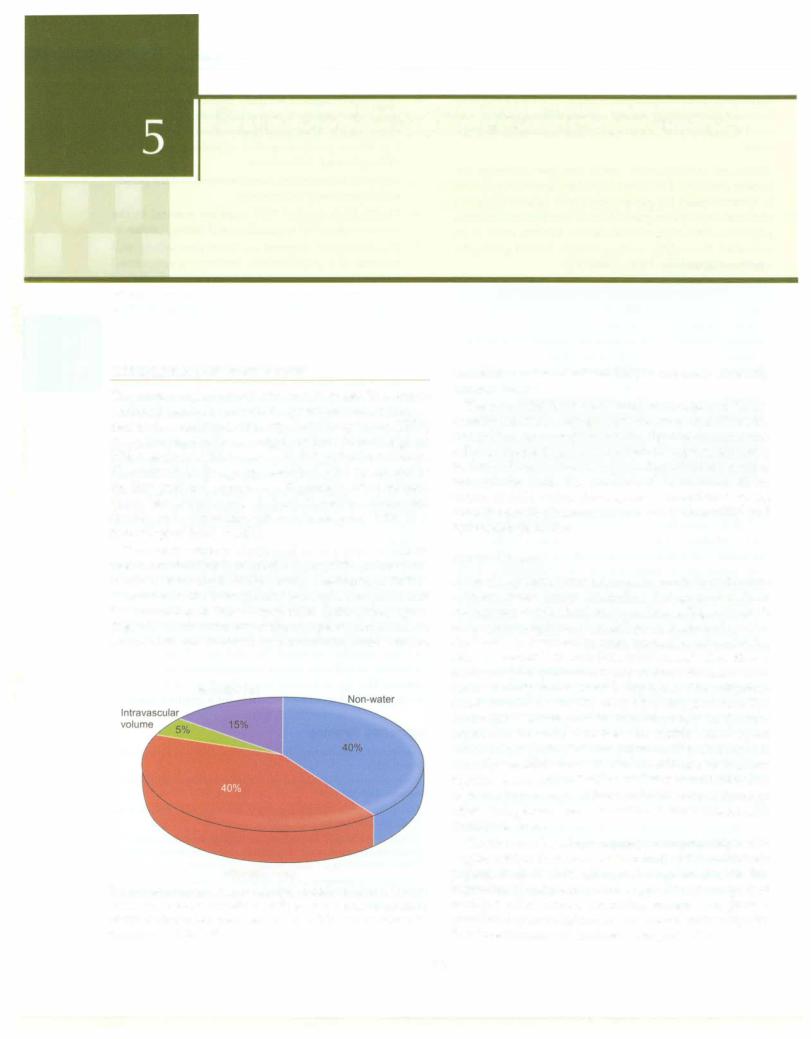
Fluid and Electrolyte Disturbances
COMPOSITION OF BODY FLUIDS
The major component of body mass is water. The contri bution of total body water to body weight varies with age, lean body weight and adiposity. Total body water (TBW) as a percentage of body weight declines from as high as 90% in early fetal life to nearly 75-80% at the time of birth. Thereafter it declines progressively to 60% by the end of the first year and remains so till puberty. Since adipose tissue has lower water content, therefore, adolescent females and overweight children have lower TBW as a percentage of body weight.
Total body water is distributed in two major compart ments, two-thirds is intracellular fluid (ICF) and one-third is extracellular fluid (ECF). Nearly one-fourth of ECF is distributed in the intravascular space (plasma water) and the remaining in the extravascular (interstitial) space (Fig. 5.1). The relative size of the two main compartments varies with age. Increase in extracellular fluid volume
Interstitial fluid
Intracellular fluid
Fig. 5.1: Body composition. Nearly 60% of the body weight is water.
Of this two-thirds is intracellular, while the rest is extracellular (ECF), which is distributed between the interstitial and intravascular compartment in 3,1 ratio
Kamran Afzal
contributes to the increased TBW in neonates, especially preterm babies.
The interstitial fluid component of extracellular fluid is actually a matrix, a collagen/gel substance that allows the interstitium to provide structural rigidity during extra cellular volume depletion. The interstitial space, especially in skin and connective tissue, is an important reservoir of extracellular fluid. The balance and appropriate distri bution of fluid within these spaces is maintained by the colloid oncotic pressure, membrane permeability and hydrostatic pressure.
Water Balance
In the steady state, water balance represents the difference between water intake (including that generated from endogenous metabolism) and water losses (Fig.5.2). Much of the water output involves obligatory losses in the urine, stool and, by evaporation from the moist surfaces of the skin and respiratory tract (insensible losses). The kidneys are the major regulators of water output with nearly two thirds of daily water losses being urine. The obligatory renal water loss is directly related to solute excretion. The evaporative losses play an important role in thermo regulation. In contrast to these insensible losses, sweat which is hypotonic (Na+ concentration 35 to 65 mEq/1) is actually 'sensible loss'. It also contributes to thermo regulation and may reflect the majority of total daily loss of water in presence of high ambient temperatures or when endogenous heat production is enhanced, as with exercise or fever.
The effectors for volume regulation are primarily renin angiotensin-aldosterone system and atrial natriuretic peptide, both of which affect Na+ excretion. Besides this regulation of body water is made possible by interplay of multiple other factors, including vasopressin, prosta glandins, dopaminergic receptors, a-adrenergic receptors, thirst mechanism and intrinsic renal properties.
70
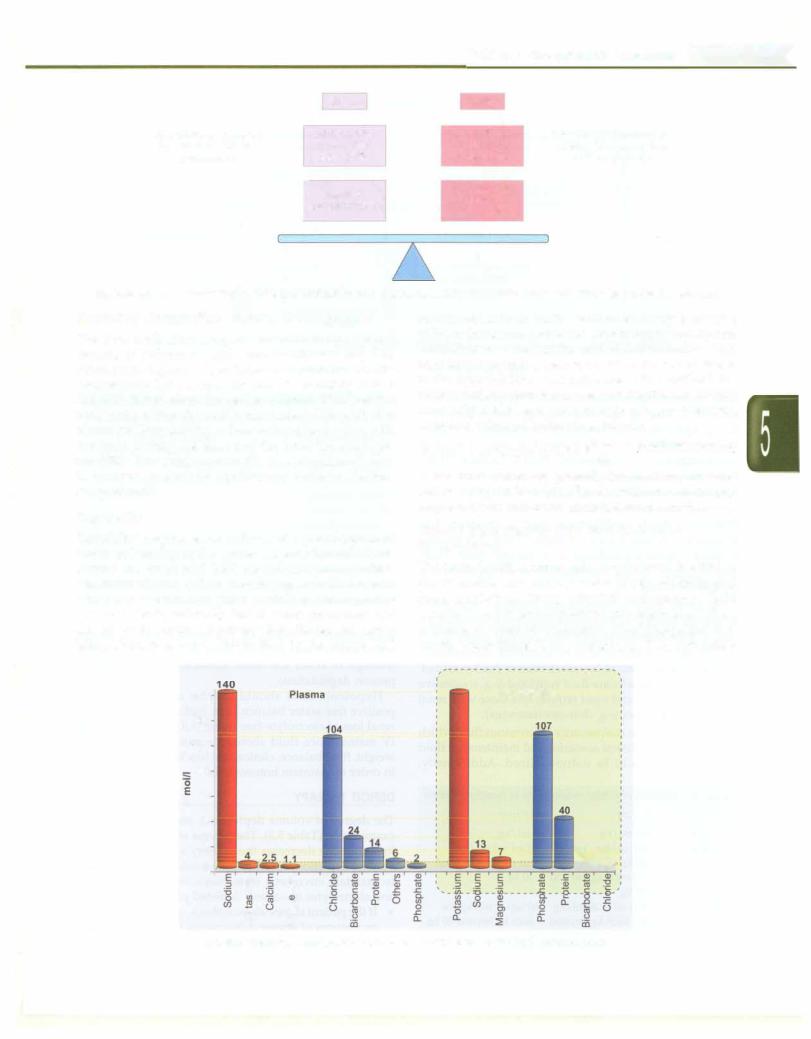
Fluid and Electrolyte Disturbances -
|
Input |
Output |
|
Water intake is regulated |
Water intake: |
Urine (60%) |
Water loss is regulated by |
by osmoreceptors in |
fluid (60%), |
Stool (8%) |
antidiuretic hormone from |
hypothalamus |
food (30%) |
Sweat (4%) |
posterior pituitary |
r |
Water of |
(28%) |
|
|
oxidation (10%) |
Insensible loss |
|
I |
skin, lungs |
|
Fig. 5.2: Balance of water intake and losses maintain normal plasma osmolality. Only water intake and urinary losses can be regulated
Electrolyte Composition of Body Compartments
The extracellular fluidcompartmentcontains high concen trations of sodium, chloride, and bicarbonate (Fig. 5.3). Potassium, organic phosphates and proteins are the predominant ICF osmoles. Because of variability in ECF and ICF distribution, the serum concentrations do not necessarily reflect the total body content of a particular electrolyte. Permeability to ions varies in each organ with the brain having the least and the liver the most per meability. However, water readily crosses cell membranes to achieve an osmotic equilibrium between the two compartments.
Osmolality
Osmolality (expressed as milliosmoles per kilogram of water, mOsm/kg) is the solute concentration of a fluid. Plasma and interstitial fluid are rich in proteins, which determine plasma colloid oncotic pressure. Changes in osmolality can produce grave neurologic consequences and even death, primarily due to water movement into and out of the brain. To prevent this, the plasma osmo lality, which is primarily determined by the plasma Na+
concentration, is normally maintained closely between 1 to 2% of the normal (285 to 295 mOsm/kg) by appropriate variations in water intake and water excretion. This regulatory system is governed by different osmo-receptors in the hypothalamus that influence both thirst and the secretion of antidiuretic hormone (ADH) (Fig. 5.4). Plasma osmolality can be measured directly using osmometers, as well as estimated indirectly as follows:
|
|
. |
= 2[N |
• |
|
|
glucose |
|
blood urea nitrogen |
|
Pl |
asma osmo a |
1ty |
|
1 |
+ |
|
|
|
|
|
|
|
|
|
|
||||||
1 1 |
|
a |
-1-8- |
+ |
2.8 |
|||||
|
|
|
|
|
|
|
||||
Measured values are generally higher than calculated values by up to 10 mOsm/kg. Increase in osmolal gap may occur due to increase in unmeasured osmoles.
Normal Maintenance Fluid and Electrolyte Requirements
The normal maintenance water requirement is equal to the insensible and urinary water losses. Holliday and Segar guidelines (1957), calculate maintenance fluid volumes to match electrolyte free water requirements from estimates of water of evaporation (heat dissipation) and caloric expenditure (heat production). They estimate a
|
|
|
140 |
Intracellular |
140 |
|
|
|
|
120 |
|
|
|
|
100 |
|
|
|
|
80 |
|
|
|
|
E 60 |
|
|
|
•• |
40 |
|
|
|
|
20 |
|
|
|
10 |
0 |
E |
E |
|
|
|
|
|
||
|
:, |
:, |
|
|
|
·;;; |
·;;; |
|
|
|
C |
|
0 |
Ol |
|
ro |
||
0.. |
||
2 |
||
|
Fig. 5.3. Electrolyte composition of intracellular and extracellular fluid compartments
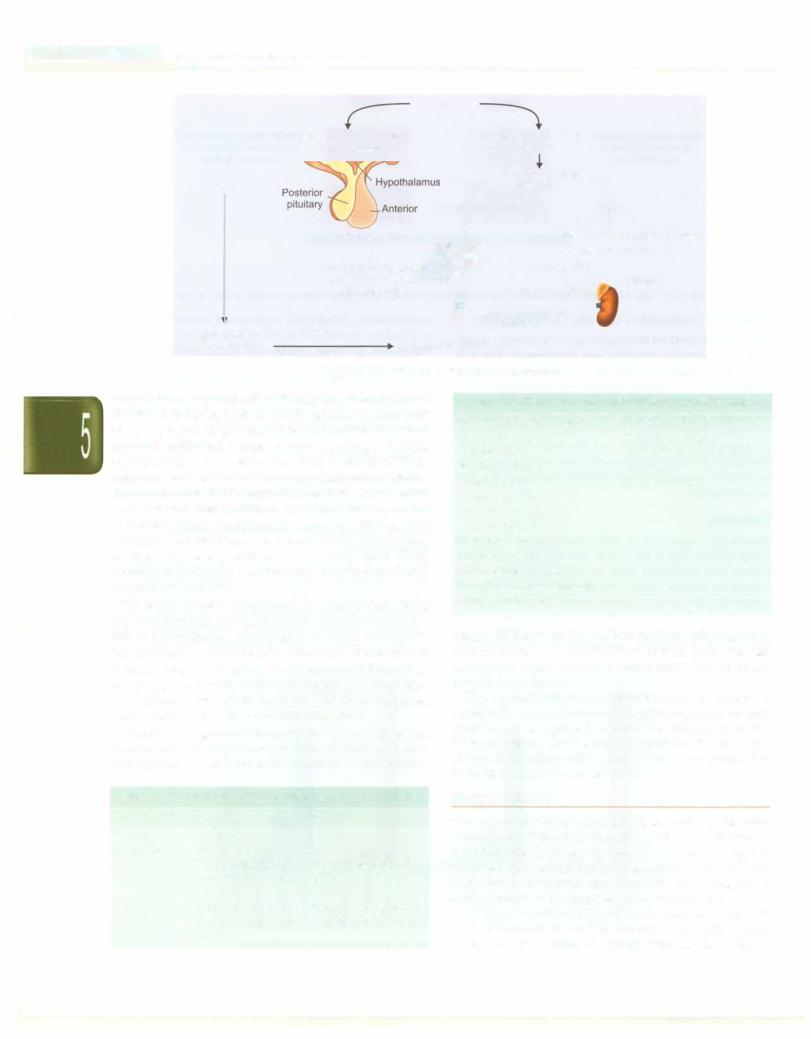
Ess entia i Pediatrics _______________________________ |
||||||||||||||||
__ |
_______________ |
Fluid loss |
|
|
|
|
|
|
|
|
|
|||||
|
|
|
|
|
|
|
|
|
|
|
|
|
|
|||
|
|
|
|
High osmolarity stimulates |
|
|
|
Decrease in blood |
|
|
||||||
|
{ |
|
osmoreceptors |
|
|
|
|
volume |
|
|
|
|
||||
|
|
|
|
/ |
Decrease in renal |
|
||||||||||
|
Thirst |
|
|
|
|
blood flow |
|
|||||||||
|
|
|
|
|
pituitary |
Decrease in GFR |
|
|
|
|
|
|
Renin |
|||
|
|
|
|
|
|
|
|
|
|
|
||||||
|
|
|
|
|
l |
|
|
|
. |
|
|
. |
|
! |
||
|
|
|
|
|
ADH secretion |
|
|
|
Ang1otensin I Angiotensinogen |
|||||||
|
|
|
|
|
water reabsorption |
,. |
|
|
|
|
j |
|
|
|
||
|
|
|
|
|
|
|
|
|
|
Ang1otens1n II |
|
|||||
|
|
|
|
|
i |
|
|
|
Aldosterone. |
+ |
|
giotensin converting enzyme |
||||
|
|
|
|
|
Freein collectingdistal tubulesductsand |
|
|
|
release+ |
Adrenal |
||||||
|
|
|
|
|
|
|
Sodium and water |
|
|
|
|
|
||||
|
Water |
|
intake |
|
|
+ |
|
retention |
|
|
|
|
|
|
||
|
|
|
|
|
|
|
|
|
|
|
||||||
reduces osmolarity |
|
Restored blood volume |
|
|
|
|
|
|
|
|||||||
Fig. 5.4. Regulation of sodium and water balance
daily sodium requirement of 3 mEq/kg, potassium and chloride 2 mEq/kg each and daily glucose requirement as 5 g/kg based on the electrolyte composition of human and cow milk and recommended 30 mEq/1 sodium chloride (saline) for maintenance fluid in children. These requirementstranslateto use ofa hypotonic salinesolution for maintenance fluids, equivalent to 0.2% saline in 5% dextrose in water and form the basis for the use of hypotonic fluids traditionally used in children. The guidelines for maintenance volume (Table 5.1) assume average calorie expenditure in a healthy child. Fluid requirements change considerably in different clinical conditions (Table 5.2).
However, there is considerable evidence that use of hypotonicfluidsin sick hospitalizedpatientsincreases the risk of hyponatremia several fold. Normal saline (0.9%) can be safely administered in standard maintenance volume without risks of hypematremia or fluidoverload, except in patients who are fluid restricted (e.g. congestive heart failure, liver and renal failure) and those with renal concentrating defect (e.g. diabetes insipidus).
There is no single maintenance intravenous fluid which is suitable for all clinical scenarios and maintenance fluid prescriptions should be individualized. Additionally,
Table 5.2: Conditions that alter maintenance fluid needs
Increased fluid requirement |
Decreased fluid requirement |
Fever (10-15% per °C |
Oliguria or anuria |
above 38°C) |
Humidified ventilator or |
Radiant warmer, |
incubator |
phototherapy |
Hypothyroidism |
Burns, sweating |
|
Physical activity; |
|
hyperventilation |
|
Diarrhea, vomiting |
|
Polyuria, renal |
|
concentrating defects |
|
Very low birth weight babies |
|
(large surface area) |
|
maintenance IV fluids do not replace daily nutrient requirements and provide only 20% of daily calories (enough to avoid starvation ketoacidosis and diminish protein degradation).
Hypotonic fluid should only be used to achieve a positive free-water balance as in replacing renal or non renal loss of electrolyte-free water. All children receiving IV maintenance fluid should be monitored with daily weight, fluid balance, clinical and biochemical parameters in order to maintain homeostasis.
Table 5.1: Maintenance fluid requirement in healthy children
Body weight |
Per day |
Per hour |
0-10 kg |
100 ml/kg |
4 ml/kg |
10-20 kg |
1000 ml for first |
40 ml + 2 ml/kg |
|
10 kg + 50 ml/kg |
for each kg beyond |
|
for each kg beyond |
10 kg |
|
10 kg |
|
>20 kg |
1500 ml + 20 ml/kg |
60 ml+ 1 ml/kg for |
|
for each kg beyond |
each kg beyond 20 kg |
|
20 kg |
|
DEFICIT THERAPY
The degree of volume depletion is assessed by physical examination (Table 5.3). The process of hypematremia or hypertonicity decreases the severity of physical signs of volume depletion. All fluid lost should be replaced daily to maintain euvolemic state. Steps for providing fluids and electrolytes to volume depleted patients are:
•If the patient shows signs of shock, compensated shock or features of severe dehydration (Table 5.3), rapidly infuse isotonic fluids to restore intravascular volume.
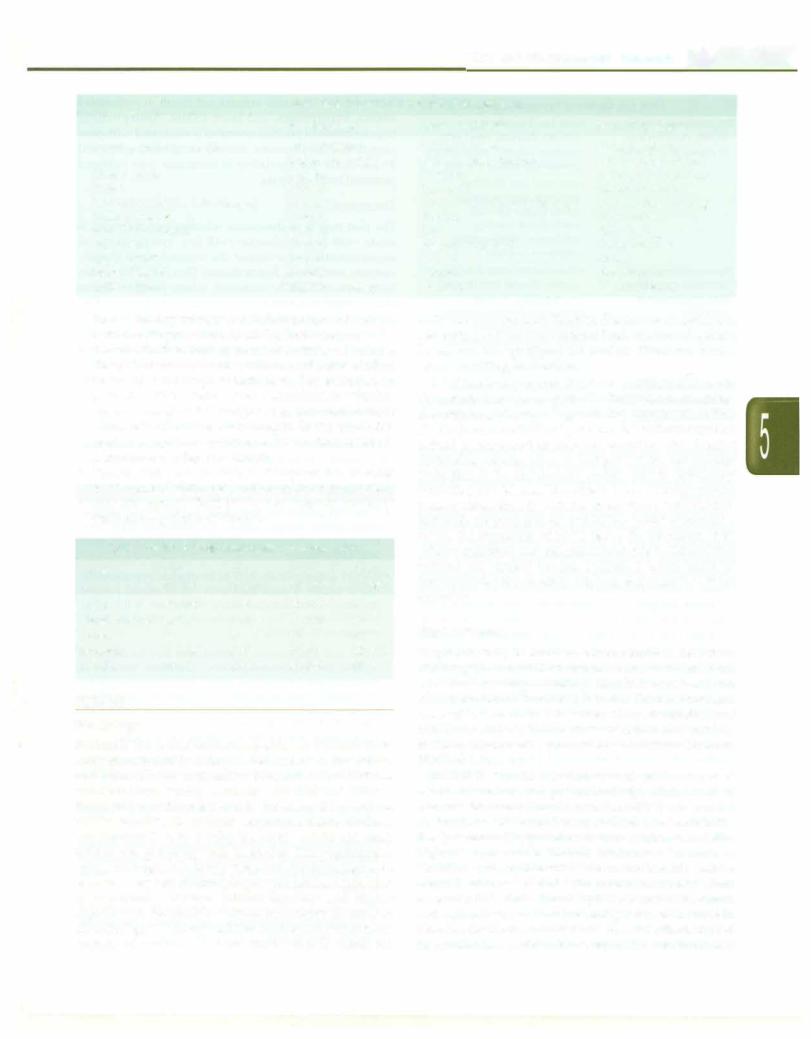
Fluid and Electrolyte Disturbances -
|
Table 5.3: Clinical assessment of dehydration |
|
|
|
No dehydration |
Some dehydration |
Severe dehydration |
Decrease in body weight |
<5% in infants; |
5-10% in infants; |
>10% in infants; |
|
<3% in older children |
3--6% in older children |
>6% in older children |
Mental status |
Normal |
Irritable |
Lethargic to comatose |
Thirst |
Normal |
Increased |
Unable to drink |
Skin color and elasticity (turgor) |
Normal |
Cool, pale; mild delay in turgor |
Cold, mottled; tenting |
Sunken eyes |
Normal |
Sunken |
Very sunken |
Mucous membrane |
Normal |
Dry |
Very dry |
Pulse rate |
Normal |
Slightly increased |
Tachycardia |
Capillary refill |
2-3 sec |
3-4 sec |
>4 sec |
Blood pressure |
Normal |
Normal |
Normal or low |
Urine output |
Slightly decreased |
Decreased |
Oliguria, anuria |
This is done by infusing 1 to 3 fluid boluses of isotonic saline or Ringer lactate, 20 ml/kg body weight.
•Provide fluids to replace calculated/observed volume deficit. This is calculated as volume at the rate of 10 ml for each percentage weight loss. For example, in patients with moderate (some) dehydration, which is on an average 7.5% weight loss, the replacement volume is 75 ml/kg body weight. If the pre-dehy drationweight isknown the volumeof fluid needed is 1 litre for every kg of weight loss.
•Provide fluid and electrolytes to replace the amounts lost in normal daily metabolism (maintenance fluids).
•Provide enough fluid to replace ongoing losses of various body fluids (Table 5.4).
Table 5.4: Electrolyte composition of body fluids
Losses |
Na+ |
K+ |
c1- |
HC03- |
|
(mEq/1) |
(mEq/1) |
(mEq/1) |
(mEq/1) |
Gastric |
60-100 |
5-20 |
90-130 |
0 |
Small intestine |
80-140 |
5-15 |
90-140 |
40 |
Colon |
60 |
30 |
40 |
15 |
Pancreas |
135-145 |
5-10 |
70-90 |
95-120 |
Diarrhea |
10-90 |
10-80 |
90-130 |
40 |
SODIUM
Physiology
Sodium is the most abundant ion of the extracellular fluid compartment and is critical in determining extracellular and intracellular osmolality. Normal serum sodium concentration varies between 135 and 145 mEq/1. Extracellular sodium balance is determined by sodium intake relative to sodium excretion. Daily sodium requirement is 2 to 3 mEq/kg body weight although intakes are generally well in excess. The requirement varies with age. It is nearly twoto three-folds higher in term and verylowbirthweightpreterm babies, a reflection of immaturity of renal tubular function and higher requirements for growth. Adult requirements decrease to 1.5 mEq/kg/d. Urinary sodium excretion represents the majority of sodium losses and approximately equals the
daily intake of sodium. Fractional excretion of sodium is generally less than 1% of filtered load. Extrarenal sodium losses can be significant via profuse sweating, burns, severe vomiting or diarrhea.
A fall in blood pressure, decrease in sodium delivery to themaculadensa,or sympathetic stimulation may activate the renin-angiotensin axis, generating angiotensin II. This resultsinincreasein bloodpressureandsodiumretention caused by enhanced aldosterone secretion. The effective circulating volume refers to that part of the extracellular fluid that is in the arterial system and is effectively perfusing the tissues. The effective circulating volume usuallyvariesdirectlywiththe extracellularfluid volume, and both are proportional to total body Na+ stores. As a result, the regulation of Na+ balance (by alteration in its urinaryexcretion)andmaintenance of effective circulating volume are closely related. Sodium loading tends to produce volume expansion, whereas loss leads to volume depletion.
Hyponatremia
Hyponatremia, defined as plasma sodium less than 135 mEq/1, can result from excessive loss of sodiumfrom excessive sweating, vomiting, diarrhea, burns and the administration of diuretics (Table5.5). The most common cause of hyponatrernia, however, is not a deficiency of total body sodium, but an excess of total body water, as in the syndrome of inappropriate antidiuretic hormone (SIADH) secretion.
SIADH is seen in association with pulmonary and cranial disorders and postoperatively. High levels of vasopressin or antidiuretic hormone (ADH) are secreted at alowthresholdorcontinuouslydespitelowosmolality. The presence of hyponatremia plus a urine osmolality higher than maximal dilution confirms the diagnosis. SIADH should be differentiated fromcerebralsalt wasting which is also associated with central nervous system disorders. In thelatter there is hypovolernic hyponatremia and high urinary sodium (>80 mEq/1) due to increase in bloodlevels of natriureticfactor(s).SIADHis characterized by euvolernia or mild volume expansion, relatively low
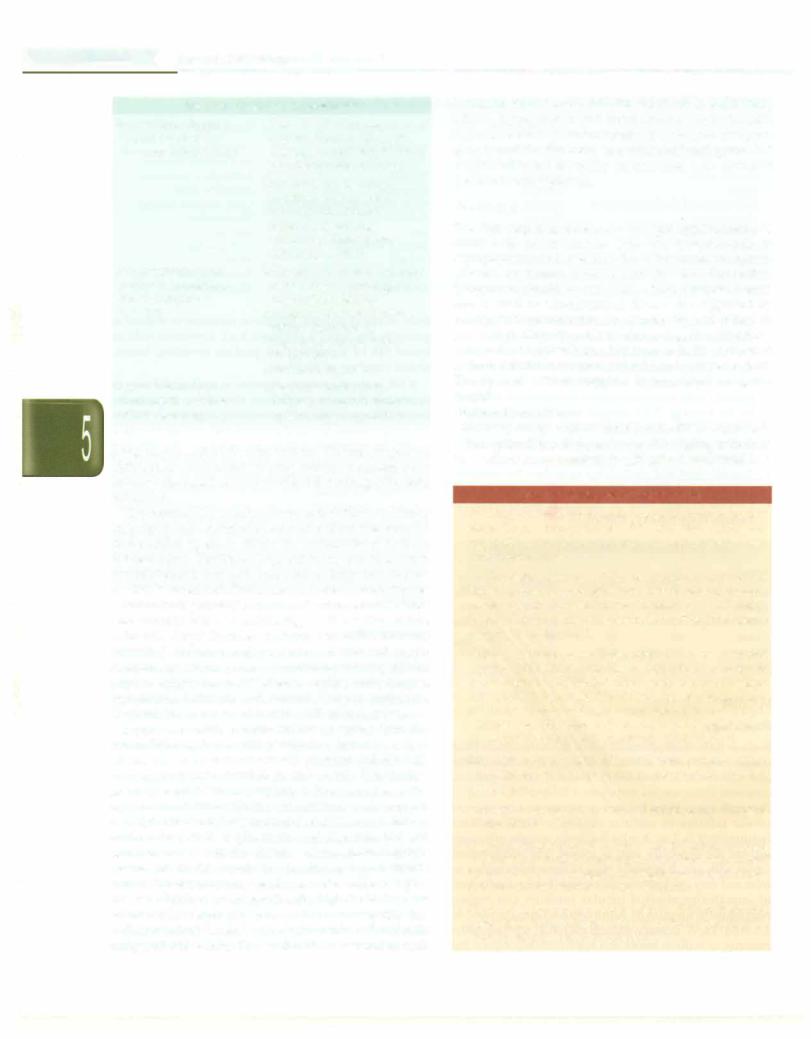
__E s s e n tial P e d iatrics_________________________________
_ _ _ _ _ _ _ _ _ _ _ _ _ _ _
Table 5.5: Causes of hyponatremia
Hypovolemic hypona tremia (sodium loss in excess of free water)
Renal loss: Diuretic use, osmotic diuresis, renal salt wasting, adrenal insufficiency, pseudohypoaldosteronism
Extra-renal loss: Diarrhea, vomiting, drains, fistula sweat (cystic fibrosis), cerebral salt wasting syndrome, third-spacing (effusions, ascites)
Normovolemic hypo |
Inflammatory central nervous |
natremia (conditions |
system disease (meningitis, |
that predispose to |
encephalitis), tumors |
SIADH) |
Pulmonary diseases (severe |
|
asthma, pneumonia) |
|
Drugs (cyclophosphamide, |
|
vincristine) |
|
Nausea, postoperative |
Hypervolemic hypo |
Congestive heart failure, |
natremia (excess free |
cirrhosis, nephrotic syndrome, |
water retention) |
acute or chronic renal failure |
urine output and high urine sodium. The treatments are different, as cerebral salt wasting requires replacement of urinary salt-water losses while SIADHismanagedby fluid restriction.
Hyperosmolality resulting from non-sodium molecules (hyperglycemia, mannitol overdose) draws water from the intracellular space to dilute the extracellular sodium concentration. Factitious hyponatremia, reported when hyperlipidemia (chylomicronemia) or hyperproteinemia coexist, isuncommondue to use ofion-selective electrodes.
Patients are generally symptomatic when serum sodium concentrationfalls below 125 mEq/1 or the decline is acute (<24 hr). Early features include headache, nausea, vomiting, lethargy and confusion. Advanced mani festations are seizures, coma, decorticate posturing, dilated pupils, anisocoria, papilledema, cardiac arrhythmias, myocardial ischemia and central diabetes insipidus. Cerebral edema occurs at levels of 125 mEq/1 or less.
Hypo-osmolality causes influx of water into the intracellular space, which results in cytotoxic cerebral edema and increased intracranial pressure and can lead to brain ischemia, herniation and death. The brain's primary mechanism in adapting to hyponatremia is the extrusion of intracellular electrolytes and organic osmolytes. Some ofthese organic osmolytes are excitatory amino acids, such as glutamate and aspartate that can produce seizures in the absence of detectable cerebral edema. Major risk factors for developing hyponatremic encephalopathyareyoungage,hypoxemiaandneurological disease. Children are at significantly higher risk than are adults for developing hyponatremic encephalopathy due to their relatively larger brain to intracranial volume ratio compared with adults. Hyponatremia in association with
increased intravascular volume can result in pulmonary edema, hypertension and heart failure. Asymptomatic hyponatremia inpretermneonatesisassociatedwith poor growth and development, sensorineural hearing loss and a risk factor for mortality in neonates who suffered perinatal birth asphyxia.
Treatment
The first step is to determine whether hyponatremia is acute (<48 hr) or chronic (>48 hr), symptomatic or asymptomatic and evaluate the volume status (hyper volemic, euvolemic, hypovolemic) (Box 5.1). The under lying cause should be corrected, where possible. Losses due to renal or adrenocortical disease are suggested by urinary sodium concentration of more than 20 mEq/1 in presence of clinically evident volume depletion (Fig. 5.5).
In case of hypovolemic hyponatremia the fluid and sodium deficit is estimated and replaced over 24 to 48 hr. The dose of sodium required is calculated using the formula:
Sodium deficit (mEq) =
0.6 x body wt (kg) x [(desired Na+) - (observed Na+)] mEq/1
The optimal rate of correction is 0.6 to 1 mEq/1/hr until the sodium concentration is 125 mEq/1 and then at a
Box 5.1: Treatment of hyponatremia
•Treat hypotensionfirst, regardless of serum sodium (normal saline bolus, Ringer lactate, 5% albumin). WHO oral rehydration solution is preferable for asymptomatic cases with hypovolemia
•Correct deficit over 48 to 72 hr for chronic hyponatremia. Rapid decline is associated with risk of central pontine myelinosis. Recommended rate of increase is 0.5 mEq/ !/hr (8-10 mEq/1/day). Correction in the first 48 hr should not exceed 15-20 mEq/1
•Acute and symptomatic hyponatremia may be corrected rapidly. For symptomatic cases, immediate increase in serum sodium level by 5-6 mEq/1 with hypertonic saline (3% saline) is recommended. IV infusion at a dose of 3-5 ml/kg over 1-2 hr will raise serum sodium by 5-6 mEq/1. Alternatively, 3% saline may be given as 1-3 boluses at 2 ml/kg/bolus over 10 min (maximum 100 ml/bolus)
•Stop further therapy with 3% saline when patient is either symptom free and/or acute rise in sodium of 10 mEq/1 is noted in first 5 hr.
•Increase of serum Na+ can be estimated using Adrogue Madias formula (Box 5.2)
•Hypotonic infusates (0.45% dextrose normal saline) are used as maintenancefluid. Normal saline should be avoided except
for correction of hypovolemia; can aggravate cerebral edema in those with impaired free water clearance.
•Fluid restriction alone is needed for SIADH; sodium and water restriction is required in hypervolemic hyponatremia. Diuretics may be added in refractory cases.
